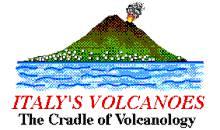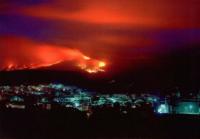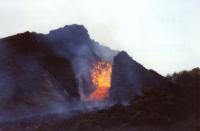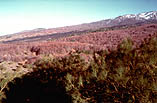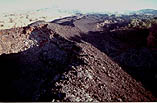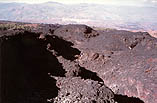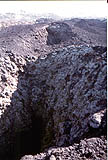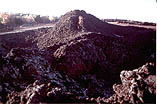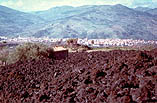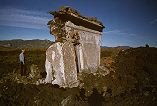| Etna
index |
||
| Geology | Geological history | Cones and craters |
| Eruptive characteristics | Eruptions before 1971 | Eruptions since 1971 |
| Etna and Man | References | Web sites |
| Weather forecasts | FAQ | Latest news |
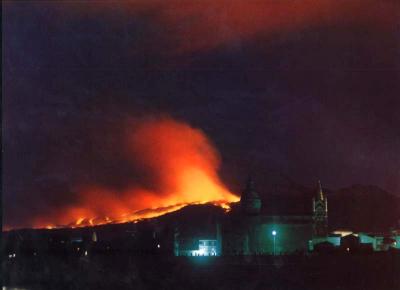
Fire near Randazzo, much too
close and extremely fast: as this photo was taken on the second night
of the March 1981 eruption, the main lava flow had barely missed the town,
but a smaller flow headed directly for the town - it was luck that it
soon lost vigor and its front stagnated only 2.5 km from the outskirts
of Randazzo. Photo was scanned from a postcard.
The 1981 NNW flank eruption
One of Etna's most dramatic and destructive eruptions of the 20th century occurred between 17 and 23 March 1981 on the north-northwestern flank of the volcano. The beautiful town of Randazzo with its medieval center narrowly excaped destruction. The eruption was particular for the length of the eruptive fracture system, its high effusion rates and for the sector of the volcano affected - no eruptive vents had opened there for many centuries and maybe up to 1000 years. Eruptions like that of 1981 are of great relevance for hazard evaluations at Etna since they leave practically no time for any kind of preventive measures and render efforts to modify the advance of the lava flows near to impossible.
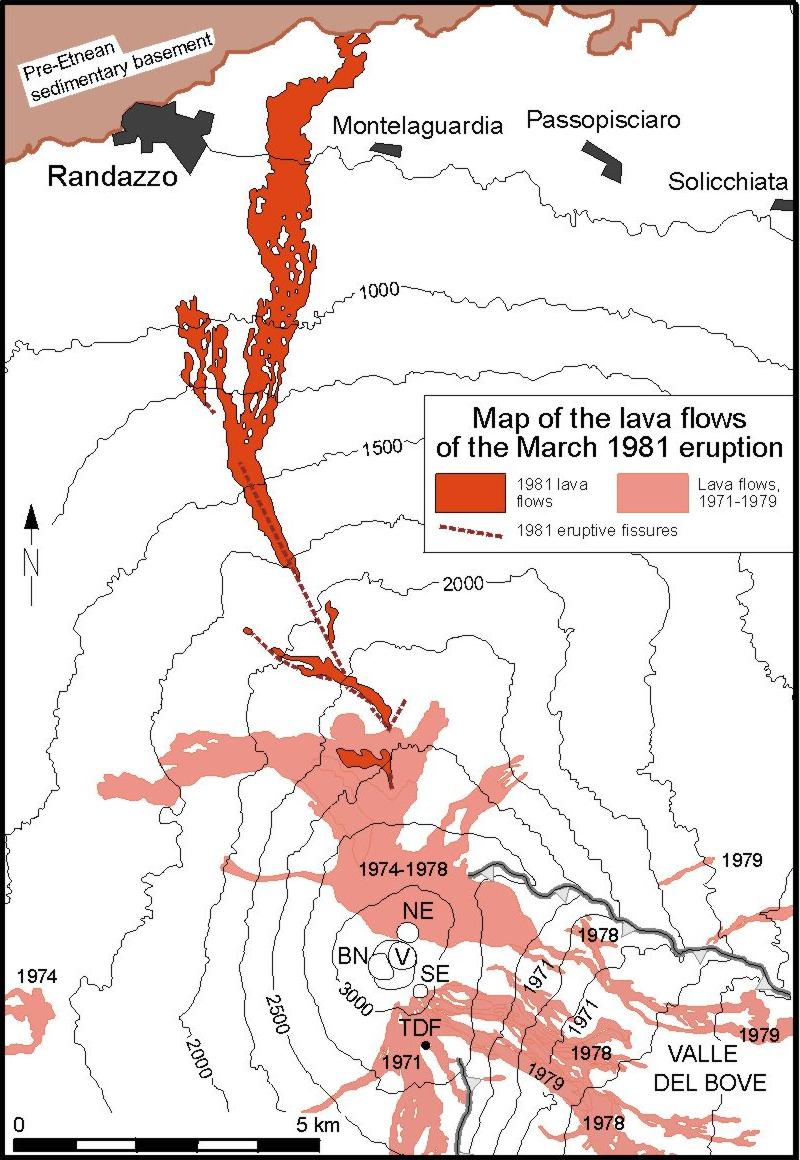
MAP OF THE 1981 LAVA FLOWS
The 1981 lava is shown in
red color. Some lava flows erupted after 1971, and before the 1981 eruption,
are shown in pink color, dates are indicated. NE=NE Crater; V=Voragine;
BN=Bocca Nuova; SE=SE Crater; TDF=Torre del Filosofo. Click on image to
get large version.
During the six months preceding the eruption, four episodes of paroxysmal activity had occurred at Northeast Crater (on 1, 6 and 26 September 1980, and again on 5-7 February 1981). These were essentially similar to the series of eruptive paroxysms between July 1977 and March 1978 at the same crater. All four episoded produced minor lava flows (up to 4 km long on 1 September 1980, 2 km long on 5-7 February 1981), and lava fountains several hundred meters high.
Premonitory seismicity began on 14 March, with epicenters in the higher part of Valle del Bove (Kieffer 1982), soon culminating in a swarm of about 500 earthquakes whose epicenters migrated towards the northern flank. Based on this seismic activity, an eruption was forecast by local volcanologists on the northern flank. In fact, at the beginning of the anticipated eruption, volcanologists from the Istituto Internazionale di Vulcanologia were in a helicopter right over the area where the first fissures split open.
The eruption was very similar to the intial stages of a typical Hawaiian eruption. As a dike propagated radially away from the summit area, eruptive fissures opened progressively at lower and lower elevations. The first vents opened at about 2550 m elevation at 1337 h local time, and lava fountains rose 100-200 m high while lava moved northwestwards. Three more fissure segments opened between 2350 and 2000 m elevation in the course of 4 hours, one of these segments being orientated west-northwestward (N60W), with an isolated vent lying more than 1 km away from the main axis of the eruptive fissure system (N25W). By 1855 h, the front of the opening fracture system arrived at 1800 m elevation where another large fissure began to open, emitting a voluminous lava flow that rapidly moved downslope. This was to become the main flow of the eruption. During the first twelve hours of its movement, it advanced about six km, seriously threatening the village of Montelaguardia (250 inhabitants) which lies about 3 km east of Randazzo.
During 18 March, this flow passsed right midway between Randazzo and Montelaguardia and entered into the bed of the Alcantara river. On its course, it interrupted several major roads, the Circumetnea railway and the Italian State railway (FS) as well as power lines, causing a temporary blackout in Randazzo that left its inhabitants in anxiety. When arriving at the Alcantara river, the flow had already slowed considerably, and there was only little movement until the flow eventually stopped on 20 March.
The eruptive fissures still propagated further downslope on early 18 March, reaching an elevation of 1300 m and emitting minor lava flows that slowly advanced in the direction of Randazzo. On the late afternoon of that day, still more vents opened down between 1200 and 1150 m elevation, and sluggish lava flows spread downslope towards Randazzo. By this time, however, the eruption had significantly diminished in vigor, and no evacuation of Randazzo was ordered, although many residents readily prepared for evacuation. In fact, mild explosive activity continued at the lowermost vents until 23 March, and the lava fronts above Randazzo kept advancing very slowly until that day, stopping 2 km from the southern margin of the town.
Today, the eruptive fissures and lava flows above Randazzo still give a feel of the 1981 drama to visitors. Although the lava is already covered with lichens, some of the vents on the fissure still emit vapor. Burnt and fallen trees cover the lava flows along their margins, and there are many spectacular lava tree molds; in some places, the remains of buildings loom out of the frozen river of black rock. The lower part of the main lava flow is used as a garbage deposit. Life in Randazzo and its surroundings is particularly peaceful, and people of the area hope that like before the 1981 eruption, many centuries will pass until the volcano erupts again in this area.
Continue
with
THE 1983 S FLANK ERUPTION
Copyright © Boris Behncke, "Italy's Volcanoes: The Cradle of Volcanology"
